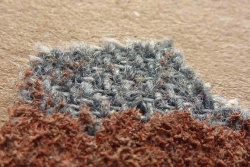Artificial leather with leather fibres on the reverse
Contents
Leather fibres on the reverse of imitation leather
In the furniture sector, synthetic leather with leather fibres glued to the reverse is processed. It's a material in which the main components are other materials than leather and only leather fibres are glued to the reverse.
Imitation leather with reverse glued leather fibres.
In advertisements, these materials are praised as "leather-like" or linked as close as possible to the term "leather". This is a false declaration, if too close. This material cannot be called genuine leather. It is also referred to as "sustainability" and "recycled leather". But ask in such cases where these statements come from.
Such materials have no advantages over "normal" artificial leather. Just because leather fibres are glued to the back, there are no leather benefits. The fibres do not have their own stability, do not serve to absorb moisture and at the very least have a minimal effect when touching the material.
Leather fibres are a waste product of the leather production and often end up in waste incineration. Since this method of back-bonding is emphasized by advertising, it must be assumed that it is also only for advertising and is an attempt to impose something "nature" on the actual artificial leather. Inquiries were made to manufacturers of these materials questioning the practical use of the gluing of the leather fibres to the reverse accept the marketing arguments. An answer has not been given.
An extreme example for incorrect declaration
There are also imitation leathers where it is not clear whether there are leather fibres glued on the reverse or whether it is thin split leather layer that has been glued. But this material also cannot be called "leather" or "genuine leather". If the layer on a leather layer is stronger than 1/3 of the total thickness, the material as a whole can no longer be called leather.
Suede or leather fibres on the reverse? In any case, it`s not "leather" In the sense of standards and consumers.
An artificial leather with leather fibres on the back, without any benefit to the customer or the sustainability or ecology.
Damage to synthetic leather with leather fibres on the reverse
In contrast to genuine leather, the life time of furniture imitation leather is often not as long as hoped. A lot of such artificial leather breaks in the wear area earlier than expected.
An extreme example for an incorrect declaration and the associated wear and tear.
There are also complaints about these types of leather in other countries. In Australia, a furniture store has sued the furniture supplier for 1,000 complaints in just one year (2013). The surface coating of artificial leather with leather fibres on the back pelted off after one to two years. Many customers bought furniture with a 5-year warranty, which didn`t cover brittle damages and cracks.
Delamination after almost two years, not covered by a 5-year warranty.
Leather mobile phone case with leather fibres on the reverse
Synthetic leather with leather fibres glued to the revers is also processed on mobile phone cases.
The stability comes from the upper, foamed and coated layer. The leather fibres are glued to the reverse and have no benefit.
Additional information
- PU leather
- Buffalo split leather
- Napalon leather
- Madras leather - Madras imitation leather
- Mobile phone cases






























 a kotori web solution
a kotori web solution